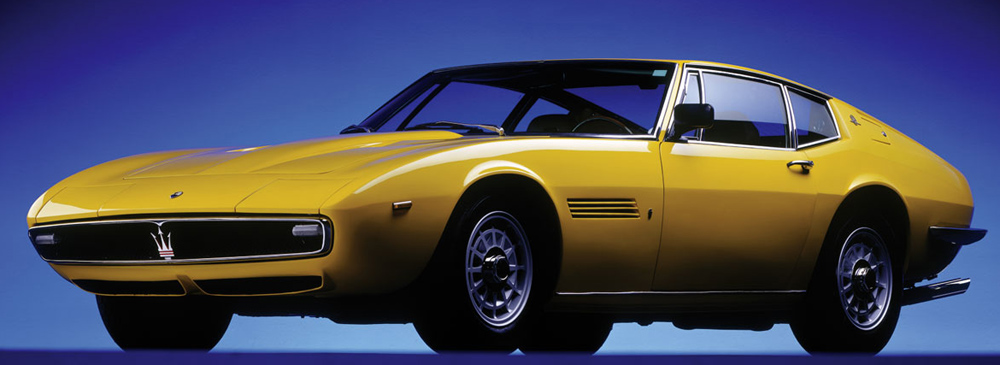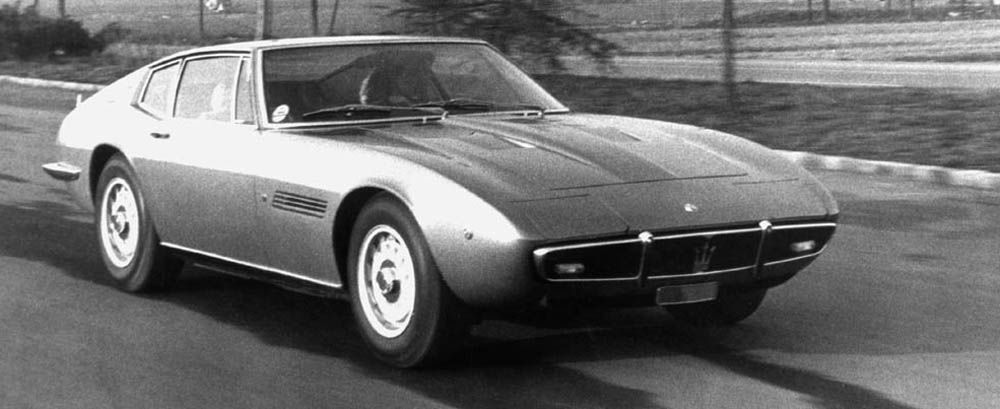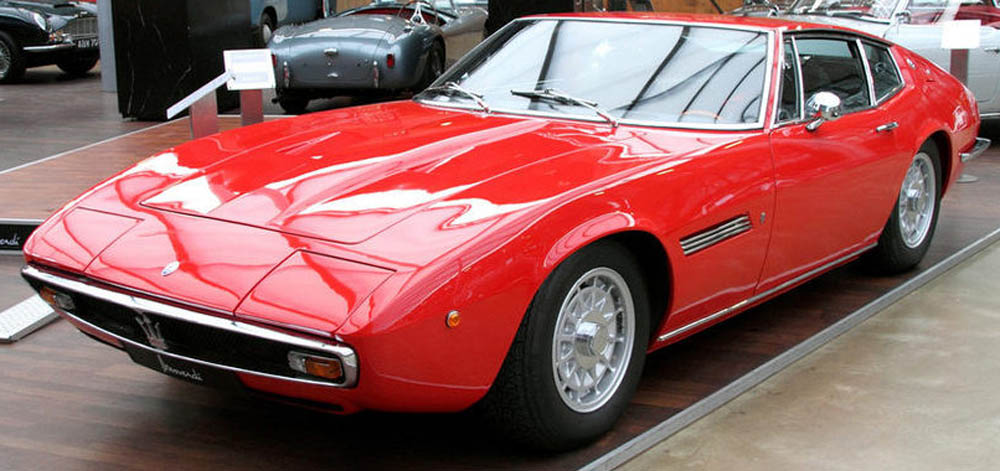
Maserati Ghibli (1967 to 1973)
The Maserati Ghibli was a high performance front-engine coupé built by Maserati between 1967 and 1973. A true thoroughbred GT, it was powered by a 4.7 liter engine developing 315 hp. The dry-sump twincam V8 engine with four twin-choke carburetors differed from that used in the Mexico and Quattroporte of the same period, which followed a wet sump design. The model was originally devised as a two-seater, despite being 4.69 meters long and having a wheelbase of 2.55 meters. The Ghibli did become a 2+2 for production.
The chassis featured simple yet effective cart-sprung rear suspension, also found on the Quattroporte II which was introduced at the same time. The project was principally overseen by Engineer Alfieri and it was unveiled at the Turin Motor Show in late 1966 on the Ghia stand, with deliveries starting in March of the following year. The steel bodies (with an alloy hood) were manufactured by Vignale.
Named after an Egyptian desert storm wind, the Ghibli had a fantastic asset in its striking visual appearance, and it could easily have sold itself based on looks alone. Its dramatic styling was the work of a young Giorgetto Giugiaro, at that time working for the Ghia studio in Turin. Giugiaro himself described it this way: “A very striking, long, flat hood, full-width radiator grille, pop-up headlights, a sharply angled windscreen, wide squat sidelights that ended in a vertical segment, and very clean flanks even though the coach-line did have lots of movement to it. The rear end was high for aerodynamic efficiency as well as functional reasons (the two fuel tanks lie behind the rear axle and have a very raised neck).”
Henry Ford II was so impressed by the Ghibli that he reportedly approached the Orsi family with an offer to buy the company from them. Other notable owners included Sammy Davis junior, Peter Sellers and Jean-Paul Belmondo.
Maserati Ghibli SS (1969 to 1973)
In 1969 Maserati launched the Ghibli SS, a sportier version of its flagship coupé with the dry-sump 90° V8 now enlarged to 4.9 liters. The dry sump design had been devised in order to best accommodate the low hood line of Giugiaro’s sleek coupé, and was later used for the very same reason on the Khamsin. Horsepower was up to 335 which gave a top speed of 280 kph (175 mph). This turned the Ghibli SS into the fastest Maserati road car in production. Prodigious braking performance came from the two twin-servo assisted ventilated discs with three pistons per caliper.
The equipment level was worthy of such a thoroughbred GT with adjustable steering column, anti-theft steering lock, leather upholstery, tinted & electric windows, reclining seats with head rests, heated rear windscreen, dashboard clock and even air conditioning all came as standard.
Technical Specifications
| Model | Ghibli |
| Maserati internal code | Tipo AM115 |
| Production start | 1967 |
| Number Produced | 1170 (all coupés combined including Ghibli SS) |
| Ignition | single-plug Bosch distributor with automatic advance, coil ignition (via a transistor from 1970) |
| Lubrication | two concentric gear pumps (pressure and scavenge) |
| Transmission | 5-speed + reverse ZF (automatic to order), self-locking differential |
| Reduction | 1:3.31 |
| Gear ratios | I=2.97; II=1.92; III=1.34; IV=1; V=0.9; R= 3.31 |
| Chassis | tubular steel ladder-frame platform chassis |
| Front suspension | double wishbones, coil springs, telescopic dampers and anti-roll bar |
| Rear suspension | leaf springs, hydraulic telescopic dampers and anti-roll bar |
| Brakes | ventilated discs, servo-assisted, hydraulic, independent dual circuit |
| Brakes front | 294 mm discs |
| Brakes rear | 272 mm discs |
| Steering | worm and sector (power assistance to order) |
| Cooling system | water-cooled |
| Length | 185.04 inches (4,700 mm) |
| Width | 70.47 inches (1,790 mm) |
| Height | 45.67 inches (1,160 mm) |
| Wheelbase | 100.39 inches (2,550 mm) |
| Front track | 56.6 inches (1,440 mm) |
| Rear track | 55.9 inches (1,420 mm) |
| Dry weight | 3416 lbs (1,550 Kg) |
| Curb weight | 3637 lbs (1,650 Kg) |
| Tires | front/rear Pirelli HS 205 VR 15 (215 VR 15 from 1972) |
| Wheels | magnesium alloy, 7.50 x 15 (wire wheels to order) |
| Top speed | 164.5 mph (265 kmh) |
| Bodywork | 2-door, 2+2 coupé |
| Fuel tank | two tanks, 100 liters (21 Imperial Gallons / 26 US gallons) |
| Production dates | 1969-1973 |
| Engine | 90° V8, light alloy casting with pressed-in cylinder liners in special cast iron |
| Bore and stroke | 93.9×85 mm |
| Total displacement | 4,709 cc |
| Displacements (unitary) | 588.62 cc |
| Compression ratio | 8.5:1 |
| Maximum power | 310 bhp at 6,000 rpm |
| Maximum torque | 47 Kgm (341 lbs/ft) at 3,500 rpm |
| Timing gear | two valves per cylinder, two chain-driven overhead camshafts per cylinder bank |
| Fuel feed | naturally aspirated, four vertical twin Weber 40 DCNF/5 carburetors (42 DCNF/9 from 1969) |
| Fuel & lubricant | N.O 98/100 RM |

| Model | Ghibli SS |
| Maserati internal code | Tipo AM115/49 |
| Production start | 1969 |
| Number Produced | 1170 (total Ghibli & Ghibli SS production) |
| Ignition | single-plug Bosch distributor with automatic advance, coil ignition (transistorised from 1970) |
| Lubrication | two concentric gear pumps (pressure and scavenge) |
| Transmission | 5-speed + reverse ZF (automatic to order), single dry plate clutch, self-locking differential |
| Reduction | 1:3.31 |
| Gear ratios | I=2.97; II=1.92; III=1.34; IV=1; V=0.9; R= 3.31 |
| Chassis | tubular steel ladder-frame platform chassis |
| Front suspension | double wishbones, coil springs, telescopic dampers and anti-roll bar |
| Rear suspension | leaf springs, hydraulic telescopic dampers and anti-roll bar |
| Brakes | ventilated discs, servo-assisted, hydraulic, independent dual circuit |
| Brakes front | 294 mm discs |
| Brakes rear | 272 mm discs |
| Steering | worm and sector (power assistance to order) |
| Cooling system | water-cooled |
| Length | 185 inches (4,690 mm) |
| Width | 70.47 inches (1,790 mm) |
| Height | 45.67 inches (1,160 mm) |
| Wheelbase | 100.39 inches (2,550 mm) |
| Front track | 56.6 inches (1,440 mm) |
| Rear track | 55.9 inches (1,420 mm) |
| Dry weight | 3,640 lbs (1,660 kg) |
| Curb weight | 3,901 lbs (1,770 kg) |
| Tires | front/rear Pirelli HS 205 VR 15 (215 VR 15 from 1972) |
| Wheels | magnesium alloy, 7.50 x 15 inch (wire wheels to order) |
| Top speed | 285 Km/h (177 mph) |
| Bodywork | 2-door, 2+2 coupé |
| Fuel tank | two tanks, 100 liters (21 Imperial Gallons / 26.5 US gallons) |
| Years of activity | 1969-1973 |
| Engine | 90° V8, light alloy casting with pressed-in cylinder liners in special cast iron |
| Bore and stroke | 3.7×3.5 inches (93.9×89 mm) |
| Total displacement | 4,930 cc |
| Displacements (unitary) | 616.16 cc |
| Compression ratio | 8.5:1 |
| Maximum power | 335 bhp at 5,500 rpm |
| Maximum torque | 49 Kgm (355.5 lbs/ft) at 4,000 rpm |
| Timing gear | two valves per cylinder, two chain-driven overhead camshafts per cylinder bank |
| Fuel feed | naturally aspirated, four vertical twin Weber 42 DCNF/11 carburetors |
| Fuel & lubricant | N.O 98/100 RM |


You must be logged in to post a comment.